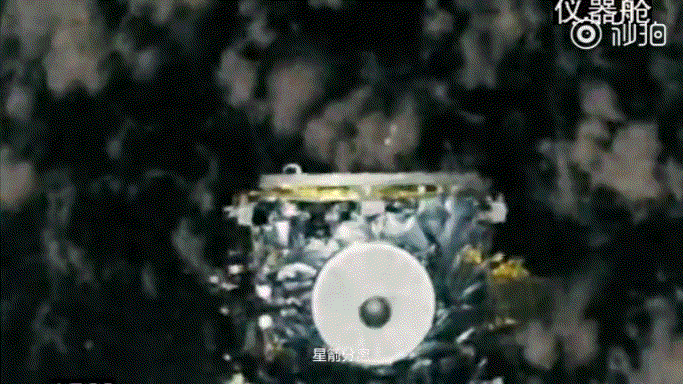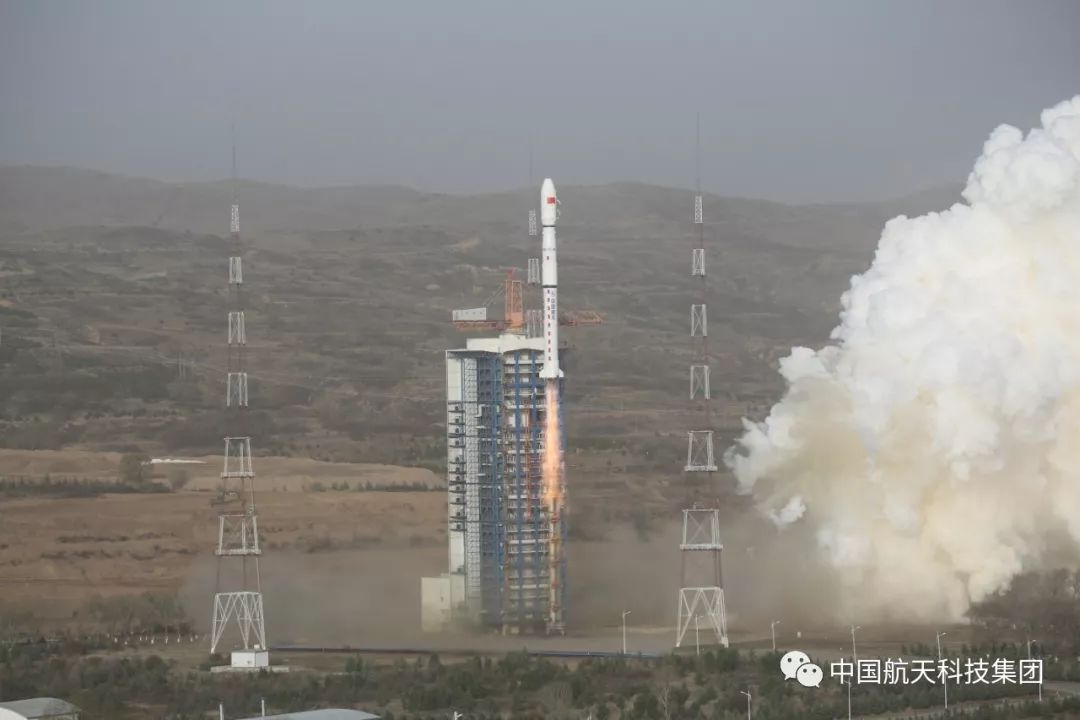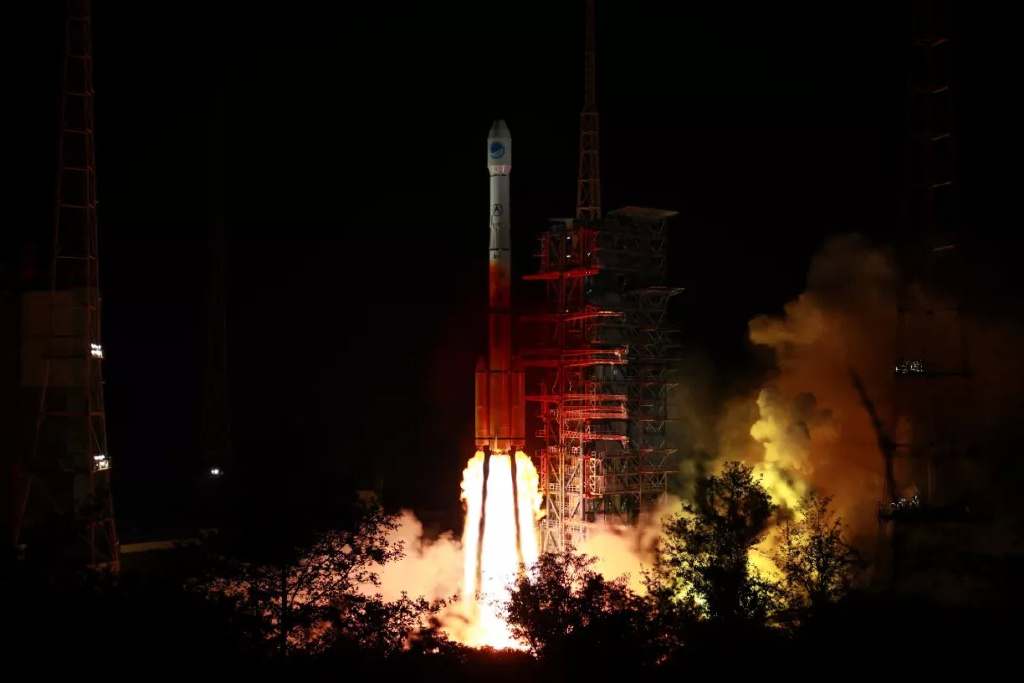How to install the app on iOS
Follow along with the video below to see how to install our site as a web app on your home screen.
Note: This feature may not be available in some browsers.
You are using an out of date browser. It may not display this or other websites correctly.
You should upgrade or use an alternative browser.
You should upgrade or use an alternative browser.
China Space Military:Recon, Satcom, Navi, ASAT/BMD, Orbital Vehicle, SLV, etc.
- Thread starter kvLin
- Start date
yusheng
FULL MEMBER

- Joined
- Sep 15, 2007
- Messages
- 1,672
- Reaction score
- 6
Chinese astronauts photographed the beautiful scenery of the earth from space.




from:
https://weibo.com/u/5616492130?refer_flag=0000015010_&from=feed&loc=nickname&is_all=1
from:
https://weibo.com/u/5616492130?refer_flag=0000015010_&from=feed&loc=nickname&is_all=1
Last edited:
samsara
SENIOR MEMBER

- Joined
- Oct 28, 2016
- Messages
- 2,793
- Reaction score
- 8
- Country
- Location
Thanks for the beautiful photos incl the one taken by the Fengyun 4A meteorological satellite this morning. I reshare those pics with friends.Chinese astronauts photographed the beautiful scenery of the earth from space.
View attachment 555035 View attachment 555036 View attachment 555037 View attachment 555038 View attachment 555039
China is gonna celebrate her SPACE DAY on 2019-04-24. Here is a cool poster released on this upcoming occasion, combining the popular traditional folklore elements of the Moon Goddess, Chang'e 嫦娥 with the modern space era ones.
As posted by OedoSoldier today:
LKJ86
ELITE MEMBER

- Joined
- Feb 1, 2018
- Messages
- 24,704
- Reaction score
- 30
- Country
- Location
bahadur999
FULL MEMBER

- Joined
- Jan 18, 2019
- Messages
- 516
- Reaction score
- 0
- Country
- Location
I think Xiamen University is also involved.
Deino
INT'L MOD

- Joined
- Nov 9, 2014
- Messages
- 12,780
- Reaction score
- 22
- Country
- Location
bahadur999
FULL MEMBER

- Joined
- Jan 18, 2019
- Messages
- 516
- Reaction score
- 0
- Country
- Location
China's Long March-5B rocket to make maiden flight in 2020
China's Long March-5B carrier rocket is scheduled to make its maiden flight in the first half of 2020, according to the China Manned Space Engineering Office (CMSEO).
As a new generation of carrier rocket, the Long March-5B has the largest carrying capacity to low-Earth orbit. It will carry the core capsule and experiment capsules of China's space station.
China's Tiangong Space Station is mainly comprised of Core Capsule, Experiment Capsule I and Experiment Capsule II, with the aim of building a reliable operating space station and providing long-term support for the onboard astronauts.
The space station project will be implemented in three phases: key technology validation, construction and operation. Six flight missions, including the maiden flight of the Long March-5B rocket and launch of the test core capsule, have been scheduled in the first phase, and launches of experiment capsules in the second phase.
China's Long March-5B carrier rocket is scheduled to make its maiden flight in the first half of 2020, according to the China Manned Space Engineering Office (CMSEO).
As a new generation of carrier rocket, the Long March-5B has the largest carrying capacity to low-Earth orbit. It will carry the core capsule and experiment capsules of China's space station.
China's Tiangong Space Station is mainly comprised of Core Capsule, Experiment Capsule I and Experiment Capsule II, with the aim of building a reliable operating space station and providing long-term support for the onboard astronauts.
The space station project will be implemented in three phases: key technology validation, construction and operation. Six flight missions, including the maiden flight of the Long March-5B rocket and launch of the test core capsule, have been scheduled in the first phase, and launches of experiment capsules in the second phase.
JSCh
ELITE MEMBER

- Joined
- Jun 9, 2011
- Messages
- 13,235
- Reaction score
- 2
- Country
- Location
From China Science Daily - on the morning of 26th April, the BDS-3 IGSO-1 satellite successful fixed at its operational inclined geosynchronous orbit.China launches new BeiDou satellite
Source: Xinhua| 2019-04-21 00:03:50|Editor: ZX
China sends a new satellite of the BeiDou Navigation Satellite System (BDS) into space from the Xichang Satellite Launch Center in Xichang, southwest China's Sichuan Province, April 20, 2019. (Xinhua/Guo Wenbin)
XICHANG, April 20 (Xinhua) -- China sent a new satellite of the BeiDou Navigation Satellite System (BDS) into space from the Xichang Satellite Launch Center in Sichuan Province at 10:41 p.m. Saturday.
Launched on a Long March-3B carrier rocket, it is the 44th satellite of the BDS satellite family and the first BDS-3 satellite in inclined geosynchronous Earth orbit.
After in-orbit tests, the satellite will work with 18 other BDS-3 satellites in intermediate circular orbit and one in geosynchronous Earth orbit.
Yang Changfeng, chief designer of the BeiDou system, said that the hybrid constellation design, in which three groups of satellites at different orbital regimes work in concert, was an exclusive BDS innovation and the world's first.
It will increase the number of visible satellites in the Asian-Pacific Region, providing better service for the region, Yang said.
The launch was the 302nd flight mission for the Long March series of carrier rockets, and the 100th for the Long March-3B.
So far, a total of four BeiDou test satellites and 44 BDS satellites have been sent to preset orbits via 36 flight missions launched by Long March-3A and Long March-3B carrier rockets.
The launch on Saturday also marked the first launch of the BDS in 2019. This year, about 8-10 BDS satellites are scheduled to be launched, wrapping up launch missions of all BDS-3 satellites in medium Earth orbit.
China began to construct its navigation system, named after the Chinese term for the Big Dipper constellation, in the 1990s and started serving the Asia-Pacific Region in 2012.
According to Yang, the positioning accuracy of the system has reached 10 meters globally and five meters in the Asia-Pacific Region after the system started to provide global service at the end of last year.
The BDS-3 system is to be completed in 2020. China is also planning to finish building a high precision national comprehensive positioning, navigation, and timing (PNT) system on the basis of the BDS by 2035.
Yang noted that China is willing to share the achievements of the BDS with other countries.
The BDS has been widely used around the world, like building construction in Kuwait, precision agriculture in Myanmar, land survey and mapping in Uganda and warehousing and logistics in Thailand.
The BDS will serve the world and benefit all mankind with more powerful function and better performance, said Yang.

JSCh
ELITE MEMBER

- Joined
- Jun 9, 2011
- Messages
- 13,235
- Reaction score
- 2
- Country
- Location
China launches two satellites for scientific experiments
Source: Xinhua| 2019-04-30 08:04:54|Editor: Lu Hui
TAIYUAN, April 30 (Xinhua) -- China successfully sent two Tianhui II-01 satellites into orbit at 6:52 a.m., Beijing Time, Tuesday from the Taiyuan Satellite Launch Center in north China's Shanxi Province.
The satellites were launched by a Long March 4B carrier rocket, which was the 303rd mission of the Long March series carrier rockets.
The satellites will be used for scientific experiments, land resource survey, geographic survey and mapping.



Source: Xinhua| 2019-04-30 08:04:54|Editor: Lu Hui
TAIYUAN, April 30 (Xinhua) -- China successfully sent two Tianhui II-01 satellites into orbit at 6:52 a.m., Beijing Time, Tuesday from the Taiyuan Satellite Launch Center in north China's Shanxi Province.
The satellites were launched by a Long March 4B carrier rocket, which was the 303rd mission of the Long March series carrier rockets.
The satellites will be used for scientific experiments, land resource survey, geographic survey and mapping.
Last edited:
JSCh
ELITE MEMBER

- Joined
- Jun 9, 2011
- Messages
- 13,235
- Reaction score
- 2
- Country
- Location
China launches new BeiDou navigation satellite
Source: Xinhua| 2019-05-18 01:12:54|Editor: Mu Xuequan
XICHANG, May 17 (Xinhua) -- China sent a new satellite of the BeiDou Navigation Satellite System (BDS) into space from the Xichang Satellite Launch Center in Sichuan Province at 11:48 p.m. Friday.
Launched on a Long March-3C carrier rocket, it is the fourth BDS-2 backup satellite and the 45th satellite of the BDS satellite family.
After being sent to the geostationary earth orbit and in-orbit tests, it will be connected to the BDS to provide users with more reliable services and enhance the stability of the constellation.
The BDS-2 system has provided stable and reliable service since it went into operation, and its positioning accuracy has improved from 10 meters to six meters.
The BDS-2 system and BDS-3 system will jointly provide services before October 2020, and after that the BDS-3 system will be the main force.
China began to construct its BDS navigation system, named after the Chinese term for the Big Dipper constellation, in the 1990s. It started serving China with its BDS-1 system in 2000 and started serving the Asia-Pacific region with its BDS-2 system in 2012. China will complete the BDS global network by 2020.
The launch was the 304th flight mission for the Long March series of carrier rockets.



Source: Xinhua| 2019-05-18 01:12:54|Editor: Mu Xuequan
XICHANG, May 17 (Xinhua) -- China sent a new satellite of the BeiDou Navigation Satellite System (BDS) into space from the Xichang Satellite Launch Center in Sichuan Province at 11:48 p.m. Friday.
Launched on a Long March-3C carrier rocket, it is the fourth BDS-2 backup satellite and the 45th satellite of the BDS satellite family.
After being sent to the geostationary earth orbit and in-orbit tests, it will be connected to the BDS to provide users with more reliable services and enhance the stability of the constellation.
The BDS-2 system has provided stable and reliable service since it went into operation, and its positioning accuracy has improved from 10 meters to six meters.
The BDS-2 system and BDS-3 system will jointly provide services before October 2020, and after that the BDS-3 system will be the main force.
China began to construct its BDS navigation system, named after the Chinese term for the Big Dipper constellation, in the 1990s. It started serving China with its BDS-1 system in 2000 and started serving the Asia-Pacific region with its BDS-2 system in 2012. China will complete the BDS global network by 2020.
The launch was the 304th flight mission for the Long March series of carrier rockets.



JSCh
ELITE MEMBER

- Joined
- Jun 9, 2011
- Messages
- 13,235
- Reaction score
- 2
- Country
- Location
China to send 6-8 BeiDou-3 navigation satellites by year-end: official
By Deng Xiaoci Source:Global Times Published: 2019/5/22 16:58:40
 Ran Chengqi, the director of China's Satellite Navigation Office,speaks at the opening of the 10th China Satellite Navigation Conference in Beijing on Wednesday. Photo: Deng Xiaoci/GT
Ran Chengqi, the director of China's Satellite Navigation Office,speaks at the opening of the 10th China Satellite Navigation Conference in Beijing on Wednesday. Photo: Deng Xiaoci/GT
China will send another six to eight BeiDou-3 (BDS-3) navigation satellites before the end of 2019, and complete construction of the BDS-3 - the new generation global navigation satellite system - by 2020, a senior official said Wednesday.
Citing official data, Ran Chengqi, head of the China Satellite Navigation Office, announced that "the overall output value for China's domestic satellite navigation industry exceeded 300 billion yuan ($43 billion) in 2018, and the scale of the industry is expected to surpass 400 billion yuan by 2020, with BDS taking up a market share worth more than 300 billion yuan during the period.
Ran made the remarks during his keynote speech at the opening ceremony for the 10th China Satellite Navigation Conference (CSNC) in Beijing on Wednesday.
The scope of BDS international applications continue to expand, Ran said, listing examples that include land rights confirmation in Indonesia and Laos, postal services and e-commerce in Uganda as well as an information rescue system and timing service at Pakistan's airports.
Currently, there are 38 BDS satellites, including 18 BDS-2 satellites and 20 BDS-3 satellites in orbit providing various services to global users, according to the official.
The sales volume of China's homegrown BeiDou navigation chips has reached more than 80 million yuan, and homegrown high precision board card and antenna products have taken up 30 percent and 90 percent of the domestic market share, respectively. The products are also exported to some 100 countries and regions.
Ran also highlighted the increasing use of BDS applications in multiple sectors in the country.
Latest data provided by the BDS official states that as of April, more than 6.2 million commercial vehicles in China are equipped with BDS. And in the first quarter of 2019, among the 116 mobile phone models that support satellite navigation and that have applied to join the Chinese network service, 82 of them are BDS-enabled.
By Deng Xiaoci Source:Global Times Published: 2019/5/22 16:58:40

China will send another six to eight BeiDou-3 (BDS-3) navigation satellites before the end of 2019, and complete construction of the BDS-3 - the new generation global navigation satellite system - by 2020, a senior official said Wednesday.
Citing official data, Ran Chengqi, head of the China Satellite Navigation Office, announced that "the overall output value for China's domestic satellite navigation industry exceeded 300 billion yuan ($43 billion) in 2018, and the scale of the industry is expected to surpass 400 billion yuan by 2020, with BDS taking up a market share worth more than 300 billion yuan during the period.
Ran made the remarks during his keynote speech at the opening ceremony for the 10th China Satellite Navigation Conference (CSNC) in Beijing on Wednesday.
The scope of BDS international applications continue to expand, Ran said, listing examples that include land rights confirmation in Indonesia and Laos, postal services and e-commerce in Uganda as well as an information rescue system and timing service at Pakistan's airports.
Currently, there are 38 BDS satellites, including 18 BDS-2 satellites and 20 BDS-3 satellites in orbit providing various services to global users, according to the official.
The sales volume of China's homegrown BeiDou navigation chips has reached more than 80 million yuan, and homegrown high precision board card and antenna products have taken up 30 percent and 90 percent of the domestic market share, respectively. The products are also exported to some 100 countries and regions.
Ran also highlighted the increasing use of BDS applications in multiple sectors in the country.
Latest data provided by the BDS official states that as of April, more than 6.2 million commercial vehicles in China are equipped with BDS. And in the first quarter of 2019, among the 116 mobile phone models that support satellite navigation and that have applied to join the Chinese network service, 82 of them are BDS-enabled.
JSCh
ELITE MEMBER

- Joined
- Jun 9, 2011
- Messages
- 13,235
- Reaction score
- 2
- Country
- Location
Yaogan-33 satellite launch failure遥感三十三号卫星发射失利
2019年05月23日 21:02:01 来源: 新华社
新华社太原5月23日电 5月23日上午,我国在太原卫星发射中心用长征四号丙运载火箭发射遥感三十三号卫星,火箭一、二级飞行正常,三级工作异常,根据测量数据监视判断,火箭三级及卫星残骸已坠落,卫星发射失利。故障排查及有关处理工作已全面展开。
May 23, 2019 21:02:01 Source: Xinhua News Agency
(Xinhua News Agency, Taiyuan, May 23rd) On the morning of May 23rd, China launched the remote sensing Yaogan-33 satellite with the Long March 4C carrier rocket at the Taiyuan Satellite Launch Center. The first and second stage rockets are normal, but the third-stage is abnormal. Tracking data show that the rocket's third-stage and satellite wreckage had fallen and the satellite launch failed. Fault troubleshooting and related processing work has been launched.
BDS-3 new signals achieve ideal accuracy: official
By Deng Xiaoci Source:Global Times Published: 2019/5/23 21:08:40

Monitoring outcomes show that new signals, codenamed B1C, from the China- developed satellite navigation system, BeiDou-3 or BDS-3, has "ideal" accuracy, according to system operating authorities on Thursday.
"For the sake of monitoring the integrity, availability and continuity of the BDS, the Application and Verifying System (AVS) has been set up to monitor and evaluate the services and performances of BDS," Guo Shengtao, an official with the Beijing Satellite Navigation Center (BSNC) said in a keynote speech at a parallel forum under the ongoing 10th China Navigation Satellite Conference (CNSC) in Beijing on Thursday.
Monitoring data collected from six domestic sites in the April shows that the average position accuracy of B1C signals was 3.1 meters horizontal-wise and 5.8 meters vertical-wise, which is "ideal at present," Guo told the Global Times, noting that the full constellation of satellites are not yet in place.
The AVS mainly consists of three parts: the verifying terminals that can communicate with signals from BDS and other global navigation satellite services, data analysis and evaluation platform placed in the BSNC and transmission networks, according to the official.
The platform collects all raw data from verifying terminals including navigation messages to conduct and analyze the BDS performances.
"Until now, there are only six monitoring points that have been deployed in China—in the cities of Beijing, Chengdu, Haikou, Kashi and Urumqi in Xinjiang Uyghur Autonomous Region, and Lhasa in Tibet Autonomous Region and there will be overseas ones in the future," he said without naming the potential sites.
B1C is the most up-to-date BDS-3 open signals.
Full constellation of the BDS-3 is scheduled to be fulfilled by 2020, and by then the system will provide highly accurate performances and services around the globe.
cirr
ELITE MEMBER

- Joined
- Jun 28, 2012
- Messages
- 17,049
- Reaction score
- 18
- Country
- Location
CZ-11 Wey carrying 7 satellites launched from offshore platform
https://sv.baidu.com/videoui/page/videoland?pd=bjh&context={%22nid%22:%226745547173581832572%22,%22sourceFrom%22:%22bjh%22}&fr=bjhauthor&type=video
https://sv.baidu.com/videoui/page/videoland?pd=bjh&context={%22nid%22:%226745547173581832572%22,%22sourceFrom%22:%22bjh%22}&fr=bjhauthor&type=video
Similar threads
- Article
- Replies
- 0
- Views
- 381
- Replies
- 30
- Views
- 2K
- Replies
- 0
- Views
- 332
- Replies
- 8
- Views
- 708



